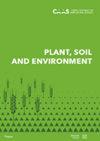沙特阿拉伯北部Al Qurayyat市一些新型非常规低成本吸附剂的合成和表征
IF 1.8
3区 农林科学
Q1 AGRONOMY
引用次数: 1
摘要
沙特阿拉伯的地下水含有高浓度的硝酸盐。硝酸盐是主要的地下水污染物,对人体健康和环境造成危害。本研究利用棕榈废弃物对沙特阿拉伯al - qurayat地区地下水中硝酸盐的去除进行了研究。棕榈纤维(PFI)和棕榈叶(PFR)最初被用作制造吸附剂的原料,通过加热到300°C来激活吸附剂。PFI和PFR的活化导致表面积增加。通过批量试验确定了PFI和PFR吸附硝酸盐的最佳环境。去除硝酸盐的最佳条件为:接触时间20 min, NO3 -初始浓度20 mg/L,投加量2 g/L, pH = 6。PFI和PFR的吸附量为72% ~ 77%。在局部最优条件下,通过与商业活性炭(CAC)和阴离子交换树脂(Purolite A 520E)的比较,发现PFI和PFR的硝酸盐去除效果不如CAC和Purolite A 520E。然而,即使在最基本的操作参数下,PFI和PFR也能够经济地去除硝酸盐。本文章由计算机程序翻译,如有差异,请以英文原文为准。
Synthesis and characterisation of some new non-conventional materials as low-cost adsorbents for removal of nitrates from groundwater in Al-Qurayyat city northern Saudi Arabia
Groundwater in Saudi Arabia contains high concentrations of nitrates. Nitrates are respected as the main groundwater pollutant causing dangerous health and environmental influences. The removal of nitrate from groundwater in Al-Qurayyat, Saudi Arabia, was investigated in this work using palm wastes. Palm fibers (PFI) and palm fronds (PFR) were initially employed as feedstock for the manufacturing of adsorbents, which were activated by heating to 300 °C. The activation of PFI and PFR resulted in an increase in surface area. Batch tests were used to determine the best environment for nitrate adsorption on PFI and PFR. The best factors for nitrate removal were as follows: the contact time was 20 min, the initial concentration of NO3– was 20 mg/L, the dose was 2 g/L and the pH was 6. The adsorption capacity of the PFI and PFR was 72% to 77%. In terms of nitrate removal effectiveness under local optimal circumstances, comparisons with commercial activated carbon (CAC) and anion exchange resin (Purolite A 520E) revealed that PFI and PFR are inferior to CAC and Purolite A 520E. However, the PFI and PFR were able to remove nitrate economically even under the most basic operating parameters.
求助全文
通过发布文献求助,成功后即可免费获取论文全文。
去求助
来源期刊

Plant, Soil and Environment
Agronomy, Soil Science-农艺学
CiteScore
4.80
自引率
4.20%
发文量
61
审稿时长
2.4 months
期刊介绍:
Experimental biology, agronomy, natural resources, and the environment; plant development, growth and productivity, breeding and seed production, growing of crops and their quality, soil care, conservation and productivity; agriculture and environment interactions from the perspective of sustainable development. Articles are published in English.
 求助内容:
求助内容: 应助结果提醒方式:
应助结果提醒方式:


